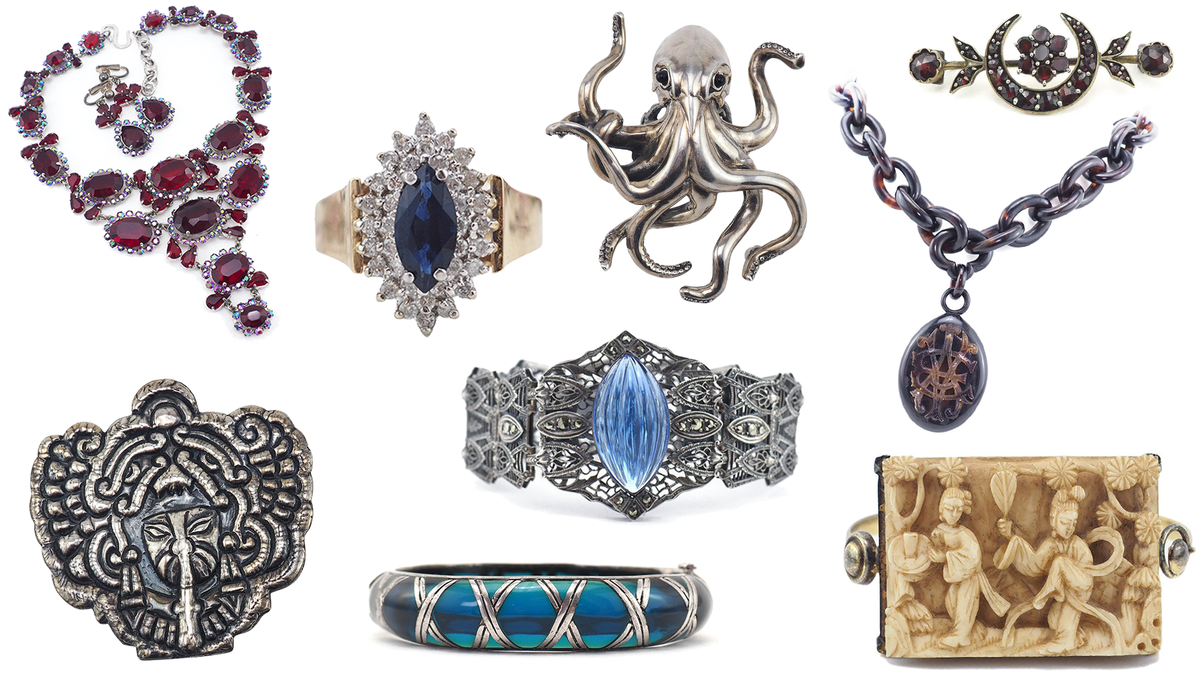What Is The Difference Between Vintage, Antique, and Estate Jewelry

Is Your Jewelry Vintage, Antique or Estate: Focus on Costume Jewelry
When it comes to costume and silver jewelry, there are many terms that are commonly used to describe pieces that are not new. Three of the most common of these terms are vintage, antique, and estate jewelry. While these terms are sometimes used interchangeably, they actually have distinct meanings that are important to understand if you are looking to buy, sell, or understand jewelry.
Vintage Jewelry
Vintage jewelry is typically used to describe pieces that are at least 20 years old but not yet 100 years old. This term is often used by vintage jewelry professionals to describe jewelry from the mid 1920s to the 1990s. Vintage jewelry is often characterized by its unique composition of materials that may not be available anymore and construction methods. These materials and construction methods often encompass elements that are less commonly encountered today, such as Bakelite, molded plastics like moonglow (popular in the 1950s), specific art glass and molded glass stones, discontinued crystals, a predominant use of Swarovski or Austrian crystals, thick anti-tarnish rhodium plating, meticulous hand soldering, prong-set stones, smooth backs (revealing the handcrafted assembly of parts rather than a single cast piece), spring rings, fold-over and hook clasps (as opposed to lobster clasps), and specific marks like "sterling" instead of "925," which typically indicate the age of an item.
Antique Jewelry
Antique jewelry, on the other hand, is typically used to describe pieces that are 100 years old or older. This term is often employed to categorize jewelry from the Georgian, Victorian, Edwardian, and Art Deco eras, each of which exhibits distinct design elements and artistic movements. Antique jewelry's allure goes beyond its age; it is characterized by a rich array of components and construction techniques that showcase the craftsmanship of bygone eras.
When delving into the realm of antique jewelry, the specific era can hold the key to understanding its unique attributes. Georgian jewelry, for instance, is known for its intricate metalwork and closed-back settings, and the use of precious gemstones like diamonds and pearls, often set in silver and gold. One particular theme to look out for with Georgian jewelry is the cluster ring.
Victorian jewelry, on the other hand, reflects the sentiments of its time, with pieces often adorned with intricate floral and symbolic motifs often crafted from various materials that are black which speaks to the popularity of using jewelry as a tool to mourn the dead.
Edwardian jewelry is celebrated for its delicate and lacy designs, featuring white metals such as platinum and white gold (or white costume metal) along with shimmering diamonds or paste. One particularly strong element of the Edwardian is the addition of little leaves, often with milgrain detail and set with glittering crystals.
Art Deco jewelry, marked by its geometric patterns and bold, contrasting colors, embodies the spirit of the Roaring Twenties. Examples include long draping beaded necklaces, baguette stone borders and lines, fun period plastics, the use of onyx, chrysoprase, clear stones, geometric glass, and generally delicate form with strong design.
In addition to these era-specific elements, antique jewelry may also bear hallmarks, engravings, or maker's marks, all of which can provide valuable insights into its origin and history. By understanding the nuances of these historical periods and examining the craftsmanship and details of antique jewelry, you can truly appreciate the artistry and timeless beauty of these unique pieces from the past. We strongly suggest visiting your local antique mall or sale and asking to hold pieces of interest of you to get a feel for period jewelry as it differs from modern jewelry.
Estate Jewelry
Estate jewelry, meanwhile, is a term used to describe any piece of jewelry that has been previously owned. This term can refer to jewelry of any age or style, and can include both vintage and antique pieces. Estate jewelry is often characterized by its uniqueness and history. In our jewelry collection, here at vintagejewelrygirl.com, estate jewelry is chosen for its materials and desirability. We select only the best, generally gravitating towards common and more unique designer names, quality materials such as sterling silver, gemstones, and genuine crystals. Each jewelry professional will have their own style of selecting jewelry. We like to curate our collection for pieces that will last a lifetime!
When it comes to buying or selling jewelry, it is important to understand the differences between vintage, antique, and estate pieces. While all three types can be valuable and beautiful, they each have unique characteristics that can affect their worth. By understanding these differences, you can make more informed decisions when it comes to buying or selling jewelry.